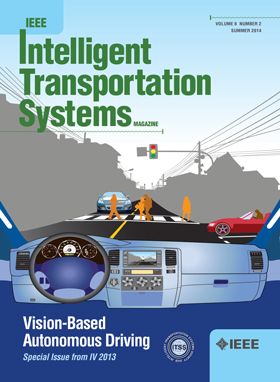An Efficient Rolling-Horizon Approach for Cooperative Multi-Lane Platoon Formation With Undefined Configurations
IF 7.9
1区 工程技术
Q1 ENGINEERING, CIVIL
IEEE Transactions on Intelligent Transportation Systems
Pub Date : 2024-10-08
DOI:10.1109/TITS.2024.3469634
引用次数: 0
Abstract
This study proposes a cooperative platoon formation scheme in a multi-lane traffic environment with connected and autonomous vehicles (CAVs). It coordinates the lane-changing decisions and longitudinal trajectories of CAVs to form platoons based on each vehicle’s target lane, aiming to reduce the negative impact of lane-changing maneuvers on traffic flow and improve platoon formation efficiency. Mathematically, a vehicle model for platoon formation is developed which couples the lateral lane-changing and longitudinal car-following behaviors of vehicles. A model predictive control-based mixed integer linear programming (MILP) problem is formulated, which optimizes all vehicles’ lateral and longitudinal trajectories and improves maneuverability and efficiency. In contrast to the majority of existing studies, the configurations of platoons to be formed are not predefined and can be jointly optimized to further improve flexibility. Moreover, the framework that integrates configuration decisions, trajectory planning and control is executed dynamically with a rolling horizon based on real-time traffic states to enhance reliability. To validate the proposed scheme, we conduct simulation experiments in SUMO to implement the cooperative platoon formation in a typical three-lane traffic flow with different traffic demand levels. The extensive comparison results indicate the superiority of the proposed method in improving traffic flow speed and platoon formation efficiency.用于未定义配置的多车道排合作编队的高效滚动地平线方法
本研究提出了一种在多车道自动驾驶汽车(CAV)交通环境中的合作排成方案。该方案根据每辆车的目标车道协调 CAV 的变道决策和纵向轨迹以形成排,旨在减少变道机动对交通流的负面影响并提高排形成效率。在数学上,建立了一个用于排成队形的车辆模型,该模型将车辆的横向变道行为和纵向跟车行为结合在一起。并提出了一个基于模型预测控制的混合整数线性规划(MILP)问题,优化了所有车辆的横向和纵向轨迹,提高了机动性和效率。与大多数现有研究不同的是,待组成的排的配置不是预定义的,可以联合优化,以进一步提高灵活性。此外,集成了配置决策、轨迹规划和控制的框架是基于实时交通状态的滚动视界动态执行的,以提高可靠性。为了验证所提出的方案,我们在 SUMO 中进行了仿真实验,在具有不同交通需求水平的典型三车道交通流中实现了合作排阵。广泛的比较结果表明,所提方法在提高交通流速度和排成队效率方面具有优越性。
本文章由计算机程序翻译,如有差异,请以英文原文为准。
求助全文
约1分钟内获得全文
求助全文
来源期刊

IEEE Transactions on Intelligent Transportation Systems
工程技术-工程:电子与电气
CiteScore
14.80
自引率
12.90%
发文量
1872
审稿时长
7.5 months
期刊介绍:
The theoretical, experimental and operational aspects of electrical and electronics engineering and information technologies as applied to Intelligent Transportation Systems (ITS). Intelligent Transportation Systems are defined as those systems utilizing synergistic technologies and systems engineering concepts to develop and improve transportation systems of all kinds. The scope of this interdisciplinary activity includes the promotion, consolidation and coordination of ITS technical activities among IEEE entities, and providing a focus for cooperative activities, both internally and externally.
 求助内容:
求助内容: 应助结果提醒方式:
应助结果提醒方式:


